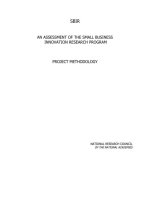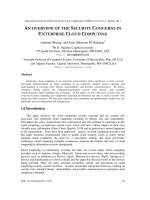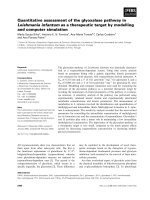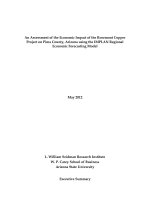An assessment of the internets potential in enhancing consumer relationships
Bạn đang xem bản rút gọn của tài liệu. Xem và tải ngay bản đầy đủ của tài liệu tại đây (3.29 MB, 389 trang )
School of Information Systems
Faculty of Business and Law
Victoria University of Technology
An Assessment of the Internet’s Potential in
Enhancing Consumer Relationships
Submitted by: Noor Raihan Ab Hamid
This thesis is presented to fulfill the requirements for the award of Doctor of
Philosophy, Victoria University of Technology
August 2006
i
Student declaration
“I, Noor Raihan Ab Hamid, declare that the PhD thesis entitled ‘An assessment of the
Internet’s potential in enhancing consumer relationships’ is no more than 100,000 words
in length, exclusive of tables, figures, appendices, references and footnotes. This thesis
contains no material that has been submitted previously, in whole or in part, for the
award of any other academic degree or diploma. Except where otherwise indicated, this
thesis is my own work”.
Signature Date
ii
Acknowledgment
This thesis would be just impossible without the blessings from Allah The Mighty and
valid support and guidance from many personalities who believe in me and my
undertakings. I would like to record my warmest gratitude to my learned supervisors,
Professor Michael McGrath and Dr Stephen Burgess whose sharp sense of research
direction have provided invaluable feedback to improve the quality of this thesis. I
would also like to thank Mr Rodney Turner for his useful comments.
To my employer, Multimedia University I owe special obligation for all the facilities
extended to me especially the financial support for the data collection phase as well as
the final cycle of my study, paving way for the accomplishment of this thesis. My
special thanks to Professor Ismail, Dean of Faculty of Management and Dr Ali Khatibi
both from Multimedia University for the wisdom of their undivided support and
encouragement particularly in the early phase of my study.
I am greatly indebted to my colleague, Dr Norizan Kassim from whom I have learnt
more about Structural Equation Modeling technique where her comments through our
series of discussions had added salt to my work. I would also like to thank my research
assistants, Khairatun Hisan and Johanniz Rosli who had energetically assisted me in the
data collection and data entry phase.
I am truly grateful to my parents for their everlasting inspiration and giving me all the
opportunities in the world to explore my potentials and pursue my dreams. I owe my
deepest gratitude to my beloved husband Abid and my three dearest children Mukhlis,
Marwan and Tasneem for their infinite patience especially during my absence for many
months. Their sincere flow of love has accompanied me all the way in my long struggle
and has pulled me through many hurdles. Hence, this thesis is dedicated to them.
iii
Abstract
Motivated by the belief, ‘to serve existing consumers costs less than acquiring new
consumers’, firms’ marketing strategies then evolve around retaining consumers and
building long-term consumer relationships. In the pursuit of acquiring consumer loyalty,
enhancing consumer value has been the focus of many firms’ relationship building
efforts. Hence, this study aims to understand the affect of using the Internet as a
relationship marketing tool on consumer retention as well as the determinants of online
consumer satisfaction affecting loyalty and retention. Although there are many factors
affecting the implementation of ‘E-CRM’, that is companies’ CRM initiatives on the
Internet channel; this study focuses on examining consumer perceptions towards the
constituents of building online consumer relationships. Adopting a positivist approach,
this research asks the following major questions: 1) How are online consumer
satisfaction, loyalty and retention constructed?, and 2) How does the use of Internet
technology in CRM influence the satisfaction, loyalty and retention of consumers? Data
for this research were collected through questionnaire survey on Internet users in major
cities of Malaysia and were analyzed using statistical techniques namely, descriptive,
Structural Equation Modeling and Multivariate Analysis of Variance.
The results from this study reveal that the use of Internet in building consumer
relationships affects consumer satisfaction, loyalty and retention. The effectiveness of
E-CRM program determines the level of which online features, such as customer service
efficiency, ease of navigation, information quality, personalization and online
community would be implemented on firms’ Web sites. In addition, older and well-
educated users, more experienced as well as users who are involved in higher risk
activities, such as online banking tend to be less tolerant. Hence, these groups of
consumers seek superior quality of services from online service providers.
This research contributes to knowledge in several ways. Most importantly, it
demonstrates the roles of Internet technology pertinent in enhancing consumer values
iv
leading to long-term consumer relationships. In particular, this research highlights the
critical dimensions of E-CRM program, which firms should invest in their consumer
retention strategies. While repeat visits do not necessarily reflect consumer loyalty and
commitment to a Web site, this research advocates that when salient elements of
building consumer relationships exist, service providers are more likely to improve
satisfaction and gain consumer loyalty. As indicated in the E-CRM model, firms’
relationship marketing strategies should focus on identifying varying consumer
expectations of service quality based on demographics, consumer level of experience
with Internet technology and perceived risk.
v
Table of Contents
Page no.
Student declaration …………………………………………………………
Acknowledgements ………………………………………………………….
Abstract ……………………………………………………………………
List of tables …………………………………………………………………
List of figures
i
ii
iii
xi
xvi
Chapter 1 Introduction …………………………………………………… 1
1.0 Introduction ……………………………………………… 1
1.1 Research problem …………………………………………. 2
1.2 Research issues and objectives ……………………………. 4
1.3 Justification for research ………………………………… 7
1.4 Research methodology …………………………………… 12
1.5 Limitation of scope to Malaysia …………………………… 13
1.6 Conclusion and organization of thesis …………………… 14
Chapter 2 Reviews of literature ………………………………………… 16
2.0 Introduction ………………………………………………… 16
2.1 Internet usage and E-commerce in Malaysia ……………….
2.2 Current trends in Internet activities …………………………
2.3 Consumers’ behaviour on the Internet: A different …………
dimension from a traditional channel
2.4 Satisfaction on the Internet …………………………………
2.5 Consumer loyalty on the Internet …………………………
16
19
20
22
25
vi
2.6 Consumer retention on the Internet ……………………
2.7 Managing customer relationships on the Internet ……….
2.7.1 Customer relationship management ……………….
2.7.2 CRM in South-East Asia …………………………
2.7.3 Electronic customer relationship management ……
E- CRM)
2.8 Conclusion ……………………………………………….
28
30
30
32
38
39
Chapter 3 Construction of research model ……………………………
40
3.0 Introduction ………………………………………………. 40
3.1 Causal Loop Diagram – A modeling approach ……………. 40
3.2 Theoretical framework …………………………………… 41
3.3 Development of research constructs ………………………. 45
3.3.1 Consumer satisfaction construct ……………………. 46
3.3.2 Consumer loyalty construct …………………………. 57
3.3.3 Consumer retention construct …….…………………. 62
3.3.4 E-CRM dimensions …………………………………. 71
3.4 Levels of model investigation …………………………… 76
3.4.1 Level one: Dimensions of satisfaction, retention ……
and loyalty
76
3.4.2 Level two: Causal structure of E-CRM, ……………
satisfaction,loyalty and retention
78
3.4.3 Level three: Relationships between consumer ……
demographics, level of experience and
perceived risk on satisfaction, loyalty and
retention.
83
Page no.
vii
3.4.4 Level four: Development of competing models … 88
3.5 Conclusion ……………………………………………… 91
Chapter 4 Research methodology ……………………………………… 92
4.0 Introduction ………………………………………………. 92
4.1 Justification of paradigm and methodology ………………. 92
4.2 Survey method and administration ……………………… 97
4.2.1 Specify the information needed ……………………. 97
4.2.2 Selection of survey method ……………………… 97
4.2.3 Specify operational definitions …………………… 100
4.2.4 Designing the questionnaire ……………………… 102
4.2.5 Exploratory (pre-test) survey and revise …………
questionnaire
105
4.2.6 Questionnaire distribution and administration …… 107
4.3 Data analysis strategy …………………………………… 111
4.3.1 Coding of responses ………………………………… 111
4.3.2 Cleaning and screening data ……………………… 112
4.3.3 Selecting a data analysis strategy ………………… 112
4.4 Ethical considerations …………………………………… 116
4.5 Conclusion ………………………………………………… 116
Chapter 5 Data analysis ………………………………………………… 117
5.0 Introduction ……………………………………………… 117
5.1 Preliminary examination of data …………………………. 117
Page no.
viii
5.1.1 Data cleaning and screening ……………………… 117
5.1.2 Descriptive analysis ……………………………… 122
5.1.3 Correlation …………………………………………. 123
5.2 Respondent profile ……………………………………… 123
5.3 Internet usage pattern …………………………………… 125
5.4 Results from tests of research propositions ………………. 127
5.4.1 Measurement model evaluation ……………………. 127
5.4.2 Structural model evaluation ………………………… 153
5.4.3 Results from tests of competing models …………… 185
5.5 Multivariate analysis of variance and test of research …….
proposition 3
193
5.6 Conclusion ………………………………………………… 201
Chapter 6 Discussion and conclusion …………………………………… 202
6.0 Introduction ……………………………………………… 202
6.1 Discussions regarding research propositions …………… 202
6.1.1 Dimensions of research constructs ………………… 202
6.1.2 Relationships between E-CRM and satisfaction, ……
loyalty and retention
205
6.1.3 The effect of demographics, experience level ……….
and perceived risk on satisfaction, loyalty and
retention
207
6.2 Implications for theory …………………………………… 208
6.2.1 Dimensions of research construct …………………… 209
Page no.
ix
6.2.2 Relationships between E-CRM and satisfaction,……
and perceived risk on satisfaction, loyalty and
retention
211
6.2.3 Demographics, experience level and perceived ……
risk influence on satisfaction, loyalty and
retention
213
6.3 Implications for practice ……………………………………. 215
6.3.1 Dimensions of satisfaction, loyalty and ……………
retention
215
6.3.2 E-CRM influences satisfaction, loyalty and …………
retention
218
6.4 The E-CRM model …………………………………………. 223
6.4.1 The E-CRM process …………………………………. 225
6.4.2 Market segmentation …………………………………. 227
6.4.3 Limitations in E-CRM implementation ………………. 229
6.5 Limitations and future directions of research ………………… 231
6.6 Conclusion ……………………………………………… 233
References …………………………………………………………………. 235
List of Appendices ………………………………………………………… 267
Appendix 4.1 Instrument used in semi-structured interview ……
with companies
268
Appendix 4.2 Research Variables, Definition and ………………
Operationalization of Variables
270
Page no.
x
Appendix 4.3a Survey instrument used in phase two of data ……
collection (Internet users) – in English
Appendix 4.3b Survey instrument used in phase two of data .……
collection (Internet users) – in Bahasa Melayu
Appendix 4.4 Factor analysis ……………………………….……
Appendix 5.1 Mahalanobis distance of outliers …………………….
277
Appendix 5.2 Assessment of Univariate and Multivariate …………
normality
306
Appendix 5.3 Multivariate normality - distribution of ……………
standardized residuals, z score below +2.58
312
Appendix 5.4 Summary of descriptive statistics: Minimum, ……….
maximum, mean, standard deviation, range and
variance.
345
Appendix 5.5 Relationships among variables – Pearson …………
correlation coefficient, two-tailed
347
Appendix 5.6 Relationships among variables – Spearman rho ……
rank coefficient correlations two-tailed
353
Appendix 5.7 Using Structural Equation Modeling (SEM)………… 354
Appendix 5.7a Discriminant validity assessment for the……………
paired constructs
365
Appendix 5.8 Legend to labeling constructs/variables…………… 366
Appendix 5.9 List of publications ………………………………… 369
Page no.
2
87
2
97
300
xi
List of Tables
Chapter 1
Table 1.1 Research Issues and Research Propositions ……………… 5
Table 1.2 Internet buyers in Malaysia, 1997-2003 (mil) ………………… 8
Chapter 2
Table 2.1 Hofstede’s Typology of National Cultures (selected …………
countries)
34
Chapter 3
Table 3.1 List of Research Issues, Dependent and Independent …………
Variables
44
Table 3.2 Empirical Measures of Consumer Satisfaction on ……………
The Internet
47
Table 3.3 Items and Dimensions of Satisfaction …………………………. 58
Table 3.4: Items and Dimensions of Loyalty 62
Table 3.5 Dimensions of Retention Construct Developed by .……………
Previous Studies
66
Table 3.6 Items and Dimensions of Retention 70
Page no.
xii
Table 3.7 42 Features of E-CRM ………………………………………… 72
Chapter 4
Table 4.1 Summary of Data Analysis Methods …………………………
115
Chapter 5
Table 5.1 Frequency of Respondent Profile ………………………………. 124
Table 5.2 Frequency of Internet Usage ………………………………… 126
Table 5.3 Goodness-of-fit Statistics for the Measurement Model of ……….
Satisfaction
128
Table 5.4 Goodness-of-fit Statistics for the Measurement Model of……….
Retention
130
Table 5.5 Goodness-of-fit Statistics for the Measurement Model of ……
Loyalty
131
Table 5.6 Goodness-of-fit Statistics for the Measurement Model of ……
Information Quality
133
Table 5.7 Goodness-of-fit Statistics for the Measurement Model of …….
Product/service Range
134
Table 5.8 Goodness-of-fit Statistics for the Measurement Model of ……
Ease of Navigation
135
Table 5.9 Goodness-of-fit Statistics for the Measurement Model of ……
Order Fulfillment
137
Table 5.10 Goodness-of-fit Statistics for the Measurement Model of …….
Customer Service Quality
138
Page no.
xiii
Table 5.11 Goodness-of-fit Statistics for the Measurement Model of ……
Lower Prices
140
Table 5.12 Goodness-of-fit Statistics for the Measurement Model of ……
Payment Security
141
Table 5.13 Goodness-of-fit Statistics for the Measurement Model of … …
Personalization Level
143
Table 5.14 Goodness-of-fit Statistics for the Measurement Model of ……
Channel Integration
144
Table 5.15 Goodness-of-fit Statistics for the Measurement Model of ……
Online Community
146
Table 5.16 Goodness-of-fit Statistics for the Measurement Model of ……
Reward
147
Table 5.17 Goodness-of-fit Statistics for the Measurement Model of ……
Trust
149
Table 5.18 Goodness-of-fit Statistics for the Measurement Model of … …
Perceived Value
150
Table 5.19 Goodness-of-fit Statistics for the Measurement Model of ……
Emotional Benefit
152
Table 5.20(a) Goodness-of-fit Statistics for a 7-dimension Structural ………
Model of Satisfaction
154
Table 5.20(b) Goodness-of-fit Statistics for a 6-dimension Structural ………
Model of Satisfaction
155
Table 5.20(c) Goodness-of-fit Statistics for a 5-dimension Structural ………
Model of Satisfaction
156
Table 5.20(d) Path Analysis Results for Dimensions of Satisfaction ………… 157
Table 5.20(e) List of E-satisfaction Measures ……………………………… 159
Table 5.21(a) Goodness-of-fit Statistics for a 3-dimension Structural ……….
Model of Loyalty
160
Page no.
xiv
Table 5.21(b) Goodness-of-fit Statistics for a 2-dimension Structural ……….
Model of Loyalty
161
Table 5.21(c) Path Analysis Results for Dimensions of Loyalty …………… 162
Table 5.21(d) List of E-Loyalty Measures …………………………………… 163
Table 5.22(a) Goodness-of-fit Statistics for a 5-dimension Structural ………
Model of Retention
164
Table 5.22(b) Goodness-of-fit Statistics for 4-dimension Structural …………
Model of Retention
165
Table 5.22(c) Path Analysis Results for Dimensions of Retention ………… 165
Table 5.22(d) List of E-Retention Measures …………………………………. 167
Table 5.23(a) Goodness-of-fit Statistics of E-CRM Program Model ………… 170
Table 5.23(b) Path Analysis Results for E-CRM Program Model …………… 171
Table 5.23(c) Goodness-of-fit Statistics for a Structural Model of …………
the Relationship between E-CRM and Satisfaction
173
Table 5.23(d) Path Analysis Results for E-CRM-Satisfaction ………………
Relationship
174
Table 5.23(e) Goodness-of-fit Statistics for a Structural Model of …………
the Relationship between E-CRM and Loyalty
176
Table 5.23(f) Path Analysis Results for E-CRM-Loyalty Relationship …… 177
Table 5.23(g) Goodness-of-fit Statistics for a Structural Model of the ……….
Relationship between E-CRM and Retention
179
Table 5.23(h) Path Analysis Results for E-CRM-Retention Relationship …… 180
Table 5.24 Goodness-of-fit Statistics for the Structural Model of the ……
Cause-effect Relationship between the Use of E-CRM
and Satisfaction -Loyalty-Retention
182
Table 5.24(a) Path Analysis Results for E-CRM-Satisfaction-Loyalty- ……
Retention Relationship – Full model
183
Page no.
xv
Table 5.25(a) Goodness-of-fit Statistics for the First Competing …………….
Model – ECRM-Satisfaction-Retention (RP2.5(a))
186
Table 5.25(b) Goodness-of-fit Statistics for the Second Competing ………….
Model –ECRM-Satisfaction-Loyalty (RP2.5 (b))
188
Table 5.25(c) Goodness-of-fit Statistics for the Third Competing ……………
Model –ECRM-Retention-Loyalty (RP2.5(c))
191
Table 5.26 Dependent Variable Measurement Items ……………………… 194
Table 5.27 Multivariate Analysis of Variance of Demographics and ………
Satisfaction, Loyalty and Retention
197
Table 5.28 Multivariate Analysis of Variance of Internet Experience …….
and Satisfaction, Loyalty and Retention
198
Table 5.29 Multivariate Analysis of Variance of Internet Activities ………
and Satisfaction, Loyalty and Retention
200
Chapter 6
Table 6.1 Results of Research Propositions and Contributions of ………
Research to Extant Literature
203
Page no.
xvi
List of Figures
Chapter 1
Figure 1.1 Internet Users vs. Internet Buyers in Malaysia ……………… 8
Chapter 2
Figure 2.1: Reasons for Not Shopping Online …………………………… 17
Figure 2.2 Internet Shopping Behaviour in Malaysia …………………… 18
Figure 2.3 Internet Purchases Trends in Australia ……………………… 20
Figure 2.4 Oliver’s Four-stage Loyalty Model ……………………………. 26
Chapter 3
Figure 3.1 Schematic Diagram for Theoretical Framework ………………. 42
Figure 3.2 End-user Computing Satisfaction (EUCS) Index …………… 48
Figure 3.3 Lee’s Model of Internet Consumer Satisfaction ………………. 49
Figure 3.4 Theories Adapted for the Dimensions of Satisfaction …………. 52
Figure 3.5 A CLD Model of ‘Satisfaction’ Construct ……………………. 57
Figure 3.6 A CLD Model of ‘Retention’ Construct ………………………. 61
Page no.
xvii
Figure 3.7 A CLD Model of ‘Loyalty’ Construct
69
Figure 3.8 A CLD Model of E-CRM Program…………………………… 73
Figure 3.9 Dimensions of E-CRM and the Adapted Theories ……………. 74
Figure 3.10 A CLD Model of E-CRM and Satisfaction …………………… 79
Figure 3.11 A CLD Model of E-CRM and Loyalty ……………………… 80
Figure 3.12 A CLD Model of E-CRM and Retention ……………………… 81
Figure 3.13 The CLD Model of E-CRM, Satisfaction, Loyalty ……………
and Retention Relationship
82
Figure 3.14 The CLD Model of Satisfaction, Loyalty, Retention …………
and Demographics Relationship
84
Figure 3.15 The CLD Model of Satisfaction, Loyalty, Retention …………
and Experience Level Relationship
86
Figure 3.16 The CLD Model of Satisfaction, Loyalty, Retention …………
and Perceived Risk Relationship
88
Figure 3.17 The CLD Model of Satisfaction and Retention ………………. 89
Figure 3.18 The CLD Model of Satisfaction and Loyalty ………………. 90
Figure 3.19 The CLD Model of Retention and Loyalty ………………… 91
Chapter 4
Figure 4.1 Outline of Research Design …………………………………… 94
Figure 4.2 Questionnaire Design Process …………………………………. 98
Figure 4.3 Organization of Jointly Funded Research Projects at ………….
Multimedia University
101
Figure 4.4 Functions of Study Variables and their Relationships ………… 114
Page no.
xviii
Chapter 5
Figure 5.1 Measurement Model of Satisfaction ………………………… 129
Figure 5.2 Measurement Model of Retention …………………………… 130
Figure 5.3 Measurement Model of Loyalty ………………………………. 132
Figure 5.4 Measurement Model of Information Quality ……………… 133
Figure 5.5 Measurement Model of Product/service Quality ……………… 134
Figure 5.6 Measurement Model of Ease of Navigation ………………… 136
Figure 5.7 Measurement Model of Order Fulfillment ……………………. 137
Figure 5.8 Measurement Model for Customer Service Quality ………… 139
Figure 5.9 Measurement Model for Price Attractiveness ………………… 140
Figure 5.10 Measurement Model for Payment Security …………………… 142
Figure 5.11 Measurement Model for Personalization ……………………… 143
Figure 5.12 Measurement Model for Channel Integration ………………… 145
Figure 5.13 Measurement Model for Online Community …………………. 146
Figure 5.14 Measurement Model for Reward ……………………………… 148
Figure 5.15 Measurement Model for Trust ………………………………… 149
Figure 5.16 Measurement Model for Perceived Value …………………… 151
Figure 5.17 Measurement Model for Emotional Benefit ………………… 152
Figure 5.18 The CLD Model of Satisfaction Construct ……………………. 157
Figure 5.19 The SEM Model of Satisfaction Construct ……………………. 158
Figure 5.20 The CLD Model of Loyalty Construct ……………………… 161
Figure 5.21 The SEM Model of Loyalty Construct ……………………… 162
Figure 5.22 The CLD Model of Retention Construct ………………………. 165
Figure 5.23 The SEM Model of Retention Construct …………………… 166
Figure 5.24 The CLD Model of E-CRM Program Model …………………. 170
Figure 5.25 The SEM Model of E-CRM program – RP2.1 ………………. 172
Page no.
xix
Figure 5.26 The CLD Model of ECRM-Satisfaction Relationship …………. 174
Figure 5.27 The SEM Model of ECRM-Satisfaction Relationship ………….
- RP2.2
175
Figure 5.28 The CLD Model of ECRM-Loyalty Relationship …………… 177
Figure 5.29 The SEM Model of ECRM-Loyalty Relationship …………….
- RP2.3
178
Figure 5.30 The CLD Model of ECRM-Retention Relationship ………… 180
Figure 5.31 The SEM Model of ECRM-Retention Relationship …………
- RP2.4
181
Figure 5.32 The CLD Model of ECRM-Satisfaction-Loyalty- ……………
Retention Relationship
183
Figure 5.33 The SEM Model of ECRM-Satisfaction-Loyalty- …………….
Retention Relationship – RP2.5
184
Figure 5.34 The CLD model of ECRM-Satisfaction-Retention …………….
Relationship
186
Figure 5.35 The SEM Model of ECRM-Satisfaction- Retention ……………
Relationship – First Competing Model RP2.5(a)
187
Figure 5.36 The CLD Model of ECRM-Satisfaction-Loyalty ……………….
Relationship
189
Figure 5.37 The SEM Model of ECRM-Satisfaction-Loyalty ……………….
Relationship- Second Competing Model RP 2.5(b)
190
Figure 5.38 The CLD Model of ECRM-Retention-Loyalty …………………
Relationship
191
Figure 5.39 The SEM Model of ECRM-Retention-Loyalty ……………
Relationship – Third Competing Model RP2.5(c)
192
Page no.
xx
Chapter 6
Figure 6.1 An E-CRM Model …………………………………………… 225
Figure 6.2 E-CRM Process ……………………………………………… 227
Page no.
An Assessment of the Internet’s Potential in Enhancing Consumer Relationships
1
CHAPTER 1: INTRODUCTION
1.0 Introduction
The emergence of Internet technology, particularly the World Wide Web, as an electronic
medium of commerce has brought tremendous changes in how companies compete in
today’s New Economy. Internet technologies provide companies with tools to adapt to
changing consumers’ needs and could be used to secure economic, strategic and
competitive advantages. Companies that do not take advantage of Internet technology
can be viewed as not delivering value added services to their consumers, and thus can be
perceived as at a competitive disadvantage. In contrast, companies that utilize this
technology (at least having a Web site that displays corporate and products information)
are viewed as progressive and continuously striving to meet the current needs of
consumers. These companies tend to have a low cost base and are able to produce
competitive high quality products. This general industrial trend has created tremendous
cost pressures on traditional businesses. Both companies and consumers acknowledge
that the Internet can be seen as an effective tool for disseminating information. From a
marketing perspective, the Internet is not merely another marketing tool, it can be a
strategic tool to help companies increase consumer satisfaction, retain consumers as well
as to acquire consumer loyalty. Hence, Internet technology is imperative in managing
customer relationships for e-businesses.
Competition becomes immensely intense as the number of Internet companies and users
grow rapidly. Most companies are facing difficulties in distinguishing themselves from
competitors and in acquiring new consumers. Consequently, most companies seem to
continuously rethink new ways of generating sales and increasing profits. These attempts
include, among others, strategizing for the “new paradigm” of relationship marketing
(Gronroos 1994; McKenna 1991; Morgan & Hunt 1994; Zineldin 2000). When a firm
has a vast consumer base with limited direct contact with its consumers, a relationship
approach is less obvious, but could well be profitable and possible ⎯ for example,
An Assessment of the Internet’s Potential in Enhancing Consumer Relationships
2
through the development of information technology and interactive media (Ab Hamid &
Kassim 2004). The elements of interactivity (Furash 1999; Walsh & Godfrey 2000) and
the ability to capture useful information from Internet technology have spurred interest in
the feasibility of streamlining information provided, forecasting consumers’ needs,
understanding preferences, delivering personalized services and enabling customization.
Thus the impetus of strategizing Customer Relationship Management (CRM), using
Internet technology as an enabling tool, escalates as firms strive to deliver value to
consumers in an intensified competitive market of cyberspace.
1.1 Research problem
Internet-based services continue to grow in importance in business-to-consumer and
business-to-business environments. From the consumer’s perspective, Internet-based
services significantly reduce the costs for searching, widen the selection of vendors,
deliver lower priced products/services, gain greater control over products/service offered
and increase convenience (Anderson & Srinivasan 2003). For firms the increased
importance of Internet channels can be seen in their contribution to disseminating
information (Cho & Park 2001), enhancing consumer value (Yang & Peterson 2004),
improving consumer satisfaction (Anderson & Srinivasan 2003) and retaining consumers,
which in turn leads to better profitability (Reichheld & Schefter 2000) and to expanded
market share.
However, with constant intense competition, an understanding of what constitutes
consumer satisfaction and loyalty is imperative in an online environment. The extent to
which a service improves consumer satisfaction may play a pertinent role in influencing
one’s intention to return. Researchers have examined the factors affecting e-satisfaction,
e-loyalty and e-retention (Anderson & Srinivasan 2003; Lee-Kelley et al. 2003).
Nevertheless, due to the dynamic nature of Internet technology, these constructs remain
elusive and rapidly changing. Failure to identify the “new” elements affecting consumer
satisfaction, loyalty and retention may lead to inferior service offerings, which fall below
consumers’ expectations as well as below industry standards at a point in time.
An Assessment of the Internet’s Potential in Enhancing Consumer Relationships
3
Identifying specific elements implicating different effects on satisfaction and repeated
patronage behaviours as well as providing services that match consumers’ expectations
are important to managers, especially in determining relationship marketing strategies.
Hence, an understanding of critical performance criteria in the assessment of satisfaction,
loyalty and retention is crucial.
As companies become more efficient in managing buyer-seller relationships, particularly
with the use of Internet (Boyle 2001; Bradshaw & Brash 2001), the need to adopt Internet
technology is obviously increasing. The trend that drives industrial changes is raising
consumer expectations and therefore companies need to refine their ability and provide
the best service to consumers in order to create loyal consumers (Ab Hamid & Kassim
2004). In order to have a better understanding of the roles of the Internet in enhancing
consumer relationships, the links between CRM attributes delivered on the Internet (E-
CRM) and consumer satisfaction, loyalty and retention merit further investigation.
Researchers have approached this issue by examining companies’ usage of the Internet in
consumer services and online communities (Adam et al. 2002; Ng et al. 1998; Poon &
Swatman 1999), evaluating E-CRM software effectiveness on customers’ businesses (de
Ruyter et al. 2001), investigating the links between E-CRM implementation on e-tailing
sites and consumer satisfaction (Lee-Kelley et al. 2003), and E-CRM attributes and their
effect on consumer loyalty (Feinberg & Kadam 2002). However, the cause-effect links
between E-CRM attributes, satisfaction, loyalty and retention, which are critical in
making decisions about how resources should be invested in building long-term
consumer relationships, ought to be examined.
Clearly, as is evident in today’s global marketing, the previously ad hoc and fragmented
techniques for dealing effectively with consumers are giving way to a more methodical
relationship marketing approach of identifying, attracting and retaining the most valuable
consumers in order to sustain profitable growth, that is, CRM (Ab Hamid & Kassim
2004). Motivated by economics of consumer management, firms have implemented
retention programs, which are aimed at exerting influence on consumers’ repeated
patronage behaviours. However, recent evidence casts doubt on the effectiveness of
An Assessment of the Internet’s Potential in Enhancing Consumer Relationships
4
some of these CRM efforts. In essence, CRM programs should be differentiated across a
consumer base in order to target more valuable accounts. Given this scenario, it is
essential for firms to understand how consumers, who vary in their attitudes and
behaviour, are from different segments of demographics, have varying years of
experiences using the Internet and levels of risk tolerance, perceive services. Knowledge
about these differences may provide useful insights in designing and implementing more
effective consumer acquisition and retention strategies. This understanding of varied
expectations from different consumer groups should be significant to managers and
clearly needs to be examined.
1.2 Research issues and objectives
The primary objectives of this study are to assess the extent to which Internet technology
can assist in building long-term consumer relationships. Based on the research problems
above, it specifically addresses the following issues:
• How are consumer satisfaction, loyalty and retention constructed?
• How does E-CRM influence the satisfaction, loyalty and retention of consumers?
• To what extent does consumers’ demographics, users’ level of Internet experience
and perceived risk influence satisfaction, loyalty and retention?
The research issues and propositions are shown in Table 1.1. In addressing the research
issues, eleven propositions are put forward to investigate the extent to which E-CRM
influences consumers’ satisfaction, loyalty and retention. According to Feinberg and
Kadam (2002), E-CRM is a term coined for CRM functions delivered via the Internet.
This research aims to measure e-satisfaction, e-loyalty and e-retention. In addition, this
study attempts to model the causal effect structure of E-CRM and satisfaction, loyalty
and retention.









